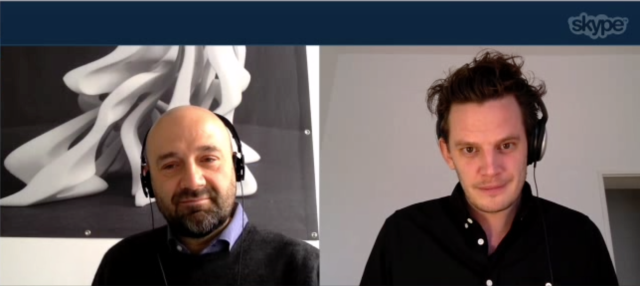Watch an Algorithm at Work
In Conversation with Jürgen Mayer H. and Tobias Nolte
Jürgen, what initially sparked your interest in Tobias’ project Mine the Scrap?
Jürgen: I was drawn to his complex concept, which linked new digital technologies, innovative approaches to design and, by extension, the basis of our daily work, to concrete and important thematics: How do we deal with resources, material rests and waste? This is a question we will be faced with increasingly in the future. Mine the Scrap is an idea that looks to the future, works with very current topics and technologies, and recombines it all innovatively. I had never seen anything like that before, and that made me curious.
How did you work together?
Tobias: Our office Certain Measures is in Cambridge, in the USA, but I’ve been coming to Berlin a lot lately. That meant we could always meet in person, fortunately, which definitely made things easier.
Jürgen: Working together really showed that, while you can obviously maintain a constant exchange via media like Skype, nothing can ever replace a one-on-one conversation. A lot does happen in informal meetings, too. You’re going for something to eat together, and then something new suddenly occurs to you. You can even see it in the development of the project. There may have been a clear concept from the outset, but especially with smaller questions and little bits of information you cull from your own network, physical proximity was a big help.
Tobias: Just yesterday, actually, I was just thinking about what the fever curve of our project Mine the Scrap had been. In the project with Jürgen, constantly connecting what we were doing back to its meaning and relevance for the here and now has been very decisive. Especially because our phantasy may run riot when we start thinking about algorithms.
To that extent, the fever curve usually started with us geeking out over the technological potentials opened up by algorithms and then turned back to how we could put them to practical use. So, the trajectory is always from absolute enthusiasm to constantly recurring task – no less enthused – to bring it all back down to earth and ask: So, how does this actually relate to reality?
Jürgen: Precisely. That way we kept widening our tunnel vision a little. (both laugh)
You can see that there’s a productive energy and that you can produce a lot in six months, which is fascinating. Other sides of the work feel somewhat stifled by this six-month limitation, like finding partners in government, business or academia, who could provide external support to the project. In that sense, presenting the project at the Forecast Festival is in no way a conclusion. It’s more like an additional impetus to keep developing these kind of topics. Because there is a lot of interest for this work and after Forecast we’ll delve deeper into its extended potentials.
Tobias: You could always say that we can start a mentoring process on our own initiative. I could have called Jürgen and said: Would you be interested in doing this together? But the thing about Forecast is that you create a space for ideas and collaborations, at all. And, what’s more, you create a public. Because if the public isn’t there, projects and ideas without budgets and clients don’t usually face the necessity of confronting the outside. As soon as there is something like Forecast, which enables people to present ideas to the public, that necessity comes into play.
In what fields could Mine the Scrap be used in the future?
Jürgen: As I see it, Mine the Scrap could be implemented in two ways, both of which would make a huge impact on architectural design and production. Locally, it could be implemented during and after catastrophes and then, internationally, as a new distribution process through Big Data. If construction waste can be reintegrated in new construction projects, that is relevant for catastrophe zones. Houses could be rebuilt out of found material left in the wake of a catastrophe. And the other important field would be the internationally hyped topic of Big Data and docking Mine the Scrap on topics like sustainability and efficiency. The work has really broad implications, which is why I at times drew Tobias’ attention from enthusiasm for algorithms to the relevancy of practical areas of application. Algorithms are exciting, they can generate great graphics, but their use and application in the design process makes his approach even more exciting.
Watching an algorithm at work: How is that imaginable?
Tobias: The best analogy for the principle behind Mine the Scrap would be that of an algorithm which suggests the best sandwich you could make when you’re standing in front of a half-empty refrigerator. But because we are architects, we don’t look in your refrigerator. Instead, we look at scrap or construction waste. The algorithm proposes the best house or the best form that could be made out of those resources. It navigates between my ideas as a designer and the options that are materially available to me. That is the principle of this technology.
Here you can find more Information about Tobias Nolte’s project Mine The Scrap.
